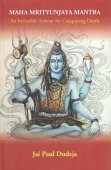Dham: 10 definitions
Introduction:
Dham means something in Hinduism, Sanskrit, the history of ancient India, Hindi. If you want to know the exact meaning, history, etymology or English translation of this term then check out the descriptions on this page. Add your comment or reference to a book if you want to contribute to this summary article.
India history and geography
Source: Shodhganga: A translation of Jhaverchand Meghanis non translated folk talesDham refers to “A sound of churning or pounding”.—It is defined in the glossary attached to the study dealing with Gujarat Folk tales composed by Gujarati poet Jhaverchand Meghani (1896-1947)

The history of India traces the identification of countries, villages, towns and other regions of India, as well as mythology, zoology, royal dynasties, rulers, tribes, local festivities and traditions and regional languages. Ancient India enjoyed religious freedom and encourages the path of Dharma, a concept common to Buddhism, Hinduism, and Jainism.
Languages of India and abroad
Sanskrit dictionary
Source: Cologne Digital Sanskrit Dictionaries: Edgerton Buddhist Hybrid Sanskrit DictionaryDham (धम्).—syllable used in learning to write, see s.v. si.
Source: Cologne Digital Sanskrit Dictionaries: Benfey Sanskrit-English DictionaryDham (धम्).—see dhmā.
Source: Cologne Digital Sanskrit Dictionaries: Cappeller Sanskrit-English DictionaryDham (धम्).—(dhmā), dhamati (te), [participle] dhamita & dhmāta blow, exhale; kindle (fire by blowing), melt (ore).
— anu blow upon. apa blow off. abhi blow at, terrify by blowing. ā inflate, blow, sound, proclaim aloud; [Passive] be inflated or puffed up. upā & samupā blow, sound. ud exhale, breathe out, proclaim. upa blow at ([accusative]). nis & parā blow away. pra blow forth, blow away i.e. terrify by blowing, blow at ([accusative]); [Middle] proclaim aloud. [Causative] blow into (a conchshell), sound. vi blow i.e. drive asunder, scatter, disperse, destroy. sam blow or melt together; proclaim aloud.
Source: Cologne Digital Sanskrit Dictionaries: Monier-Williams Sanskrit-English Dictionary1) Dham (धम्):—or dhmā [class] 1. [Parasmaipada] dhamati ([Ātmanepada] te, [Upaniṣad; Mahābhārata]; p. dhmāntas = dhamantas, [Bhāgavata-purāṇa x, 12, 7]; perf. dadhmau, 3. [plural] [Ātmanepada] mire, [Mahābhārata]; [Aorist] adhmāsīt, [Kāvya literature]; Prec. dhmāyāt or dhmeyāt [grammar]; [future] dhamiṣyati, [Mahābhārata]; dhmāsyati, dhmātā [grammar]; [indeclinable participle] -dhmāya, [Brāhmaṇa])
—to blow (either intrans. as wind [applied also to the bubbling Soma, [Ṛg-veda ix, 73]] or trans. as, to blow a conch-shell or any wind instrument), [Ṛg-veda] etc. etc.;
—to blow into ([locative case]), [Mahābhārata l, 813];
—to breathe out, exhale, [Ṛg-veda ii, 34, 1; Mahābhārata xiv, 1732];
—to kindle a fire by blowing, [Ṛg-veda ii, 24, 7; Mahābhārata ii, 2483];
—to melt or manufacture (metal) by blowing, [Ṛg-veda] etc. etc.;
—to blow or cast away, [Mahābhārata v, 7209] :—[Passive voice] dhamyate, [Epic] also ti, dhmāyate, ti ([Śatapatha-brāhmaṇa; Mahābhārata]) to be blown etc.:—[Causal] dhmāpayati, [Mahābhārata] ([Aorist] adidhmapat [grammar]; [Passive voice] dhmāpyate, [Mahābhārata])
—to cause to blow or melt;
—to consume by fire, reduce to cinder, [Mahābhārata; Suśruta] :—[Desiderative] didhnāsati [grammar]:—[Intensive] dedhmīyate, [Pāṇini 7-4, 31];—dādhmāyate, p. yamāna being violently blown (conch-shell), [Bhāgavata-purāṇa i, 11, 2.]
2) cf. [Slavonic or Slavonian] dumo ‘smoke’
[Sanskrit to German]
Sanskrit, also spelled संस्कृतम् (saṃskṛtam), is an ancient language of India commonly seen as the grandmother of the Indo-European language family (even English!). Closely allied with Prakrit and Pali, Sanskrit is more exhaustive in both grammar and terms and has the most extensive collection of literature in the world, greatly surpassing its sister-languages Greek and Latin.
Hindi dictionary
Source: DDSA: A practical Hindi-English dictionary1) Dham in Hindi refers in English to:—(nf) a thud, report resulting from the fall of a heavy object or its movement on the ground; ~[dhama] recurrence of the sound of [dhama; —se] with a report or thud..—dham (धम) is alternatively transliterated as Dhama.
2) Dham in Hindi refers in English to:—(nm) residence, abode; seat of a diety; the four chief pilgrimage centres (of the Hindus)..—dham (धाम) is alternatively transliterated as Dhāma.
...
Kannada-English dictionary
Source: Alar: Kannada-English corpusḌhaṃ (ಢಂ):—[noun] the blasting sound of crackers or fire arms (when a shot is fired).
Kannada is a Dravidian language (as opposed to the Indo-European language family) mainly spoken in the southwestern region of India.
Nepali dictionary
Source: unoes: Nepali-English DictionaryDham is another spelling for धाम [dhāma].—n. 1. abode;
Nepali is the primary language of the Nepalese people counting almost 20 million native speakers. The country of Nepal is situated in the Himalaya mountain range to the north of India.
See also (Relevant definitions)
Starts with (+598): Dhama, Dhamabhaj, Dhamacaukadi, Dhamacchad, Dhamachad, Dhamachhad, Dhamadha, Dhamadham, Dhamadhama, Dhamadhamana, Dhamadhamanem, Dhamadhamay, Dhamadhamaya, Dhamadhamayati, Dhamadhami, Dhamadhamisu, Dhamadhamita, Dhamadhipa, Dhamadhuma, Dhamadhumu.
Ends with (+1374): A-car-kariyavatam, A-vitam, Abhidham, Abhisamdham, Abhivardham, Abhyardham, Acamarutam, Acammatam, Acanipatam, Acankatam, Accutam, Accuvametam, Accuvatitam, Acetam, Acevakavatam, Acipatam, Acirvatam, Acitam, Aciyapotam, Acotam.
Full-text (+153): Udgadha, Midha, Dhama, Upagudha, Vadha, Hodha, Idha, Dhma, Dhmata, Nivyudha, Gudha, Avisodha, Adhirudha, Lekhyarudha, Alidha, Surudha, Virudha, Avagadha, Ratharudha, Kalaprarudha.
Relevant text
Search found 17 books and stories containing Dham, Ḍhaṃ, Ḍham; (plurals include: Dhams, Ḍhaṃs, Ḍhams). You can also click to the full overview containing English textual excerpts. Below are direct links for the most relevant articles:
The Agni Purana (by N. Gangadharan)
Chapter 25 - Worship regarding Vāsudeva, Saṅkarṣaṇa, Pradyumna and Aniruddha
The Garuda Purana (by Manmatha Nath Dutt)
Chapter XII - Description of the order to be observed in the course of worship < [Agastya Samhita]
Chapter X - The mode of worshipping the goddess Lakshmi < [Agastya Samhita]
Chapter VII - Description of the sun-worship etc. as performed by the Self-origined Manu < [Agastya Samhita]
Sripura (Archaeological Survey) (by Bikash Chandra Pradhan)
The Fortress < [Chapter 2 - The Architectural Panorama]
Guide to Tipitaka (by U Ko Lay)
Part VII - Patthana Pali < [Chapter X - Abhidhamma Pitaka]
Part II - Vibhanga Pali < [Chapter X - Abhidhamma Pitaka]
Part 5 - Paiicaka Nipata Pali < [Chapter VII - Anguttara Nikaya]
Folk Tales of Gujarat (and Jhaverchand Meghani) (by Vandana P. Soni)
Chapter 14 - Noli Nom < [Part 3 - Kankavati]
Chapter 39 - Parkaya Pravesh < [Part 5 - Rang Chee Barot]
Chapter 38 - Chhar Sar < [Part 5 - Rang Chee Barot]
Puranic encyclopaedia (by Vettam Mani)
Related products
